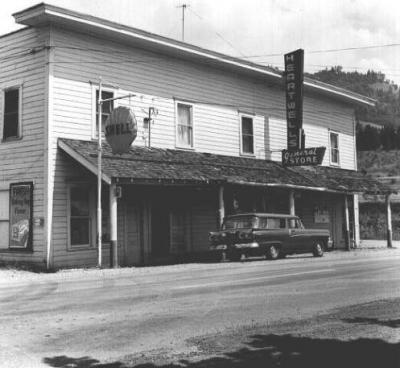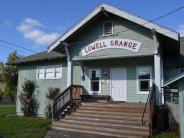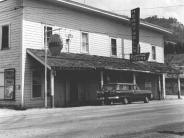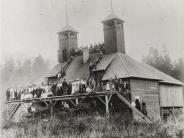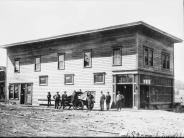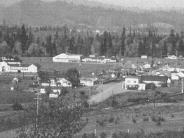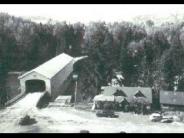-
Government
-
Column 1
- City Council
- Agendas & Minutes
- Strategic Plan
- Municipal Code
- Forms & Applications
- Key Documents
- Email Subscriptions
Column 2
- Boards & Committees
- BBJ Festival Committee
- Budget Committee
- Economic Development Committee
- Library Committee
- Parks & Recreation Committee
- Planning Commission
- Downtown Master Plan
- Development Code Update Project
Column 3
-
-
Community
-
Column 1
Column 2
Column 3
-
- Business
- Visitors
- I Want To...
History
According to the state geologist, 10,000,000 years ago the SW slope of Disappointment Butte failed in a catastrophic landslide which gave the Butte its distinctive flat slope, and which makes it possible to dig a hole 20 feet deep at the base of the slope without hitting bedrock. The slide buried a conifer forest which included a deciduous redwood species (the Dawn Redwood) which was thought to be extinct until about 40 years ago when a remnant population was discovered growing in China. Petrified Dawn Redwood logs have been exposed by erosion northeast of the BPA transmission lines on the southern side of the Butte.
Archaeologists tell us that Calapooya people lived in the upper portion of the valley and that the Mollala people lived in the foothills of the Cascades and had a camp near here. When Lane County was repairing the street in front of the high school two weeks ago the SHPO called and shut the contractor down. The state said that there had been a native village located between the high school and the Forest Service office and work must stop until archaeologists could study the site. The Mollala picked a good place to live, except for the heavy truck traffic.
In the early 1850's, a wagon train attempted to use a new free wagon road which was reported to enter the middle fork valley, by crossing the Cascades at a point near Summit lake. Unfortunately the new road had been blazed but never constructed, which made their rate of travel quite a bit slower. As winter approached, the emigrants sent one of their members (a Mr. Blanding) ahead to the valley to get help. When Mr. Blanding reached the future site of Lowell his horse went into labor and delivered a still-born colt. Blanding built a fire to roast the colt. Settlers saw the smoke and suspecting it to be the work of hostile natives, went to investigate. When they found Blanding they sent help back up the river for the remaining emigrants. Those helpful settlers may have been John Powell and John Barkdull, whose Donation Land Claims here were surveyed in 1859.
In 1874 Amos Hyland moved here with his family (he had 14 kids) from Junction City. Our first post office was established in 1880 and was named Cannon, probably after Jake Cannon, a local resident. Amos’ son-in-law was postmaster. Three years later when folks got tired of their mail being sent to Cannon Beach and Canyon City the post office name was changed to Lowell. Oregon Book of Geographic names reports that Hyland named the post office after his home town of Lowell, Maine. The town of Lowell, Maine has a population of about 300 and the people at their town hall told me they have never heard of Amos. Amos’s obituary said that he came from Will County Illinois. Although Ohio and Maine both have adjacent small towns named Lowell and Dexter, there is a community called Lowell in Illinois but it is located 50 miles west of Will County.
Amos Hyland owned several thousand acres here. He ran livestock, grew hops logged and was one of the founders of Booth Kelly Lumber company in Springfield. When the railroad began looking for a route to California Amos recognized that a railroad would be a better way to get his cattle, hops and logs to market than cattle drives, wagons and river drives, but the railroad company wanted to locate through towns that had both potential riders and a labor supply to cut the firewood necessary to power their steam engines. Amos developed a plan to plat the center of his property as the Town of Lowell in order to entice the railroad to locate here. Unfortunately, Amos passed away in 1905, 3 years before the tracks were laid through Lowell. The town was officially platted in 1910 by Amos’ heirs.
According to the State Mortuary Board, our Hyland cemetery was originally known as Howe cemetery. The first burials in the cemetery were reportedly in 1865 when Eli Bagley’s daughters, Mary and Matilda, and his granddaughter Katie drowned when a wheel lynch pin on their buckboard broke while they were crossing the Willamette River. John Bagley is credited with officially creating the cemetery in 1867. Amos Hyland held title to the property and subsequently set aside the community burial site as a public cemetery and the adjacent property as a place to hold church camp meetings, both under the trusteeship of the Methodist Episcopal Church.
Agnes Stewart, a Fall Creek resident who taught the previous year in Springfield, taught school here in 1856, probably in the log schoolhouse formerly located on the Hyland property on the northeast corner of 2ndand Moss Streets. In 1913 the community constructed a new schoolhouse on the Hyland property land adjacent to and south of the old schoolhouse, and the old school was used as a play shed. That new building is now known as Lowell Grange Hall. Grange archives indicate that the Lowell White Oak Grange was active in 1913, but held its meetings elsewhere. Our high school archives indicate that in 1930 Grange meetings were held in the new Lowell Union High School gym. About this time our Grange became known as Lowell Grange, rather than Lowell White Oak Grange. The High School was constructed on land donated by Al and Lee Wetleau. The Wetleaus boarded high school students from logging camps, including the school’s student body president (Nils Hult) the captain of the school’s basketball team (Nils Hult) and the editor of the school newspaper, the Lowell High Broadcaster, (who was also Nils Hult). During the 30s and 40s Lowell had a sawmill operated by the Hult family, and one operated by Bert Fegles and later by Butte Lumber Company. Lewis Lumber Company operated a planing mill at the Pengra siding 2 miles west of Lowell for roughly 20 years beginning in about 1919. Rough lumber was transported to the planning mill via a six mile long flume operated cooperatively by three mills located near Zion Church on Lost Creek. The flume crossed the highway on the east side of Webber’s Market in Dexter and was suspended over the river. Also in the 30s, the grade school (our Grange hall) was remodeled to add the stage. In 1940 Lowell’s current grade school was constructed to replace grade schools located in the communities of Winberry, Unity, Lowell, Landax and Eula, and the Hyland family then sold this building to the Grange. Over the following 10 years the Grange added indoor plumbing and a kitchen.
A flag created in 1942 by Lowell High School students indicates that our community had 71 graduates and former students serving their country in the armed forces. That is quite a lot for a school with just 50 students.
The current Lowell Bridge was constructed in 1945 to replace an earlier covered bridge. In 1948 work began to move the railroad to the south side of the river, and to raze the communities of Eula, Landax, Lawler, Signal, Reserve and Carter, and the farms and orchards between them, in order to flood the area for Lookout Point Reservoir. The Forest Service ranger station at West Boundary was moved to Lowell and folks interred in cemeteries located in areas to be flooded were reburied at Mt. Vernon Cemetery in Springfield. Butte Lumber Company in Lowell burned in 1953 after it lost its rail siding, and was not rebuilt.
The City of Lowell was incorporated in 1954 to acquire the sewer plant and water system developed by the U.S. government during construction of Lookout Point and Dexter dams. All city council meetings were held in the Grange Hall until a city hall was constructed 20 years later. The Grange Hall continued to be Lowell’s official polling place until ADA requirements caused the precinct to be moved to Lowell High School. The Grange Hall has been the center of community activities including Christmas Bazaars, Old Time Fiddlers’ jam sessions, quilt shows, community Halloween parties, scout meetings, birthday parties, sock hops, weddings, baby showers, and funerals.
Amos’s son Grant reportedly operated a dental office in the General store he built about 1915 on the northwest corner of Hyland and Main Streets. Prior to 1958 Lowell had a pool hall and a roller rink. Newcomers can hardly imagine but during the period 1958 through 1962 Lowell supported a drug store, a liquor store, three cafes, five gas stations, two general stores, two barber shops, a tackle store, a shoe store, a hotel, a bulk fuel dealer, a wrecking yard, two tow truck businesses, an auto mechanic shop, a plywood patch manufacturing plant, and an American Legion Hall. Between 1964 and 1966 Fall Creek reservoir was constructed and flooded farms that previously grew pole beans, strawberries, corn and hay and pastured livestock. Although Lowell’s population today is double that of 1960, the loss of the area farms and sawmills due to dam construction and the loss of logging, sawmill and Forest Service jobs due to changing federal forest management policy has led our population to find work in Eugene and Springfield. Since they are commuting to the metro area they tend to also shop there. The resulting decline in local demand for goods and services in Lowell led to the closure of most of our retail businesses.
In the late 1970's, a volunteer fire department district was organized in the Lowell-Fall Creek area, to replace the unorganized volunteer fire department we had previously. Our previous department was rather informal and was only equipped with a manually transported hose reel and a Pulaski, which were housed in a lean-to shed situated where the present LTD bus stop is located. Although our community dairy closed in the 70s one of the former bean fields is now a major blueberry plant producer. In 1992 the Hayden family opened a dental office here; a store-n-lock opened, and a hairdresser set up shop here. In 1994 the City of Lowell completed an industrial park on the northern edge of the community and recruited Tumac to move their high tech manufacturing plant and approximately 20 jobs to Lowell.
In about 1985, the bell tower was removed from the Grange hall, the schoolhouse-red cedar lap siding was covered with T1-11 and a comp roof was installed over cedar shingles. In 2005 the Grange Hall was recognized with designation as a state and federal historic site, which we hope will allow us to restore the bell tower and siding, level the kitchen floor and add a wheelchair ramp.

